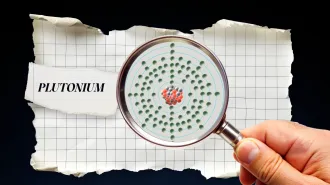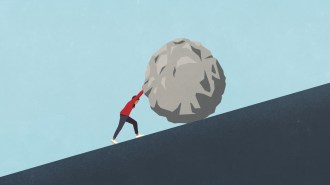For popularity on Twitter, partisanship pays
Users who try to spread bipartisan links suffer from less popularity than partisan tweeters

Much digital ink has been spilled about whether our views make it out of the circle of our like-minded friends. A new study shows that, on Twitter at least, they don’t.
ALotOfPeople/istockphoto
- More than 2 years ago
When it comes to politics, people on one side of the aisle often love to accuse everyone on the other of living in an echo chamber. Liberals hear only what they want to hear, while conservatives read only the news they agree with. (Of course, all those making the accusations are not in bubbles themselves. Oh no, of course not.)
A study published earlier this year suggests that those bubble accusations may be true — at least on Twitter.
Twitter users are most exposed to, and engage most with, the viewpoints that are closest to their own, the study shows. Those who do try to bridge the partisan divide suffer the ultimate social media consequence — less popularity.
Computer scientist Kiran Garimella of Aalto University in Finland started out studying algorithms that might show how polarization arises on social media. But in 2016, fate intervened. “Luckily Trump and Brexit happened, and polarization became more mainstream,” he recalls. Garimella no longer needed to try to predict if polarization would occur; it was happening right on his computer screen. So Garimella began to look at where echo chambers of that polarization might exist, and what it meant for the people in them.
Garimella and his colleagues examined more than 100 million publicly available tweets from 2015 to 2016 that were in a series of public datasets. The scientists focused specifically on political hashtags such as #guncontrol, #Obamacare and #abortion and on tweets surrounding the 2016 United States presidential election. They also included a large dataset of 2.6 billion tweets from people who retweeted presidential and vice-presidential candidates from 2009 to 2016.
And the researchers examined tweets by people the users followed to study the content the users were consuming. They also built a model to represent the social connections among the users. Finally, the scientists analyzed the tweets themselves for their political leanings, examining which publications tweets linked to, and rated those publications on a scale from left-leaning to right-leaning.
The researchers compared tweets on those political hot topics to a smaller control set of around 48 million tweets on nonpolitical (and — in theory — nonpartisan) issues, including #gameofthrones, #ff (for follow Friday), #tbt (throwback Thursday), #love and #foodporn.
The control topics showed only one lump in the middle of the graph; there’s very little ideology in fire-breathing dragons and beauty shots of food. But when political tweets and Twitter users were broken down by their political leanings, the tweets neatly gathered into two distinct lumps — one on the political left, and one on the right. Conservatives tweet conservative links, and liberals tweet liberal links.
And that goes for the tweets of people they followed too. “We find that a majority of users produce and consume content from the same ideology,” says Garimella. “This is evidence that people are in these echo chambers because they aren’t being exposed to the other side.”
Not only that, people who tweet more partisan content tend to have more influence, what Garimella calls “central to their networks.” They have more followers of a similar mindset, and their tweets get more retweets. A good example, he notes, is President Donald Trump. “Trump is an influencer. Anything he posts gets a lot of attention,” Garimella says. Partisanship pays.
There were a relatively small number of users who followed and tweeted about news from both sides of the political spectrum. But “if you’re bipartisan, you’re punished for being bipartisan,” Garimella explains. Those users are “less popular, less influential in their networks and their content gets less engagement.” Ouch. He and his colleagues posted their results January 5 at arXiv.org.
Many users of social media would probably like to think they are among the bipartisan few, hearing and sharing content from both sides. But, Garimella shows that is just not true. “People get riled up for partisan content.”
The research is interesting evidence of echo chambers on Twitter, says Folker Hanusch, who studies journalism at the University of Vienna in Austria. And, he notes, it makes good sense. “It’s why the opinion sections of newspapers are the most popular,” he says. “People like having their own opinions reinforced.”
But he notes that readers should “be wary of making grand statements that people are living in bubbles.” Twitter is only one part of a person’s life (hopefully). Family, friends and workplaces might help expose partisan users to other points of view. “Users might have a bubble on Twitter, but it’s not the only interaction they have with other people,” he notes. It’s not the only exposure to news, either. People might consume partisan content from Twitter, but they might also go elsewhere for other content — stories they might not rush to tweet to their partisan following.
Still, Garimella notes, the promotion of only partisan content isn’t doing anyone any favors. “Platforms like Facebook and Twitter have made it easier for people to be encompassed in their own bubbles,” he says. “It makes it easy to hate the other side.” And if you’re not deliberately seeking news outside a certain sphere, “you’re getting biased information, and you’re not aware you’re not getting information outside of the bubble.”
Garimella hopes that maybe this will make a few people think before they tweet. “You might not know that when you ‘like’ [or retweet] a partisan tweet you’re in a larger context doing a disservice to society,” he says. “You’re making things more polarized.” Choosing to tweet more moderately might be a tiny way to contributed to a more balanced society — though you might end up with fewer followers along the way.







